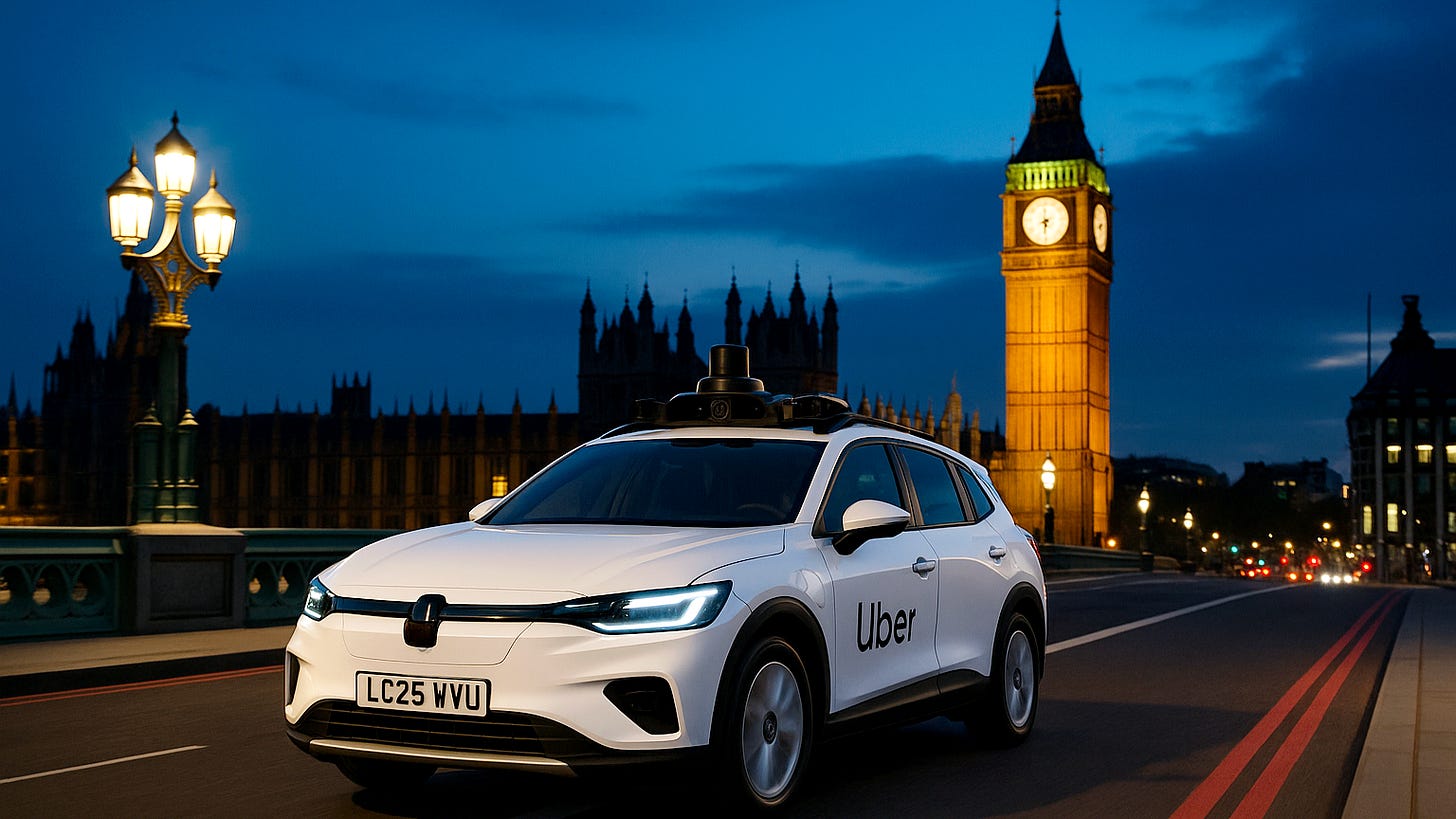📰 A Driverless Uber in London — Is This a Turning Point for Uber?
Uber starts testing fully self-driving rides in London. Why does this test matter? What does it mean for Uber? And could it shake up the global robotaxi race?
Uber UBER 0.00%↑ has just announced that it’s teaming up with UK-based AI startup Wayve to launch trials of fully autonomous vehicles on the streets of London. These are Level 4 self-driving cars, meaning they don’t need a human behind the wheel — not even as backup.
This is Uber’s first real test of true driverless technology in Europe. The vehicles will run on Wayve’s Embodied AI platform, which learns to drive like a human — by reacting to real-world situations instead of following detailed maps or pre-programmed instructions.
This trial is happening thanks to new UK regulations that fast-track testing and approval of autonomous vehicles. If successful, these robotaxis could officially hit the road by 2026.
Why this test really matters
Plenty of self-driving tests have already happened in U.S. cities like San Francisco and Phoenix. But those cities are relatively simple compared to London, where traffic is unpredictable, the streets are narrow and winding, and the road rules are often very different.
London is chaotic — and that’s exactly what makes it the perfect testing ground.
As Wayve CEO Alex Kendall put it, “If it works here, it can work anywhere.” This test isn’t just a trial. It’s a proof of concept. Can this AI-driven car handle one of the toughest driving environments in the world?
If it can, then scaling to other cities becomes much easier — and much faster.
What this means for Uber
Uber has had a complicated history with autonomous driving. Years ago, it tried to build its own self-driving tech but pulled the plug after accidents, delays, and mounting costs. Since then, Uber has changed course — now it’s working with outside tech partners who specialize in autonomy.
That strategy is paying off. Uber is already working with Waymo in the U.S. and Pony.ai in China. Now, with Wayve, it’s back in the self-driving game in Europe and this time, it’s doing it smarter.
If this test works, it could lead to:
Fewer human drivers needed over time
Lower operating costs and higher profit margins
A more consistent experience for riders across cities and countries
In short: Uber doesn’t want to build the self-driving cars itself anymore. It wants to be the platform that connects the best autonomous tech to passengers, anywhere in the world.
The robotaxi race
Uber isn’t alone. All around the world, companies are racing to bring robotaxis to the streets:
Waymo (owned by Google) is already offering fully driverless rides in Phoenix and San Francisco.
Cruise (backed by GM) showed early promise but had to pause operations after safety concerns.
Tesla has long promoted its Full Self-Driving system, which until now still required human supervision. But this week, Tesla is finally kicking off a fully driverless pilot in Austin — with no one behind the wheel. A small fleet of Model Ys is expected to start testing on June 12, in carefully selected parts of the city under close monitoring.
In China, companies like Baidu, WeRide, and Pony.ai are also moving fast and testing in multiple cities.
But the biggest challenge for all of them? Scaling.
Most systems today rely on detailed maps and only work in specific zones. That makes it hard to expand quickly. Wayve’s AI-driven approach is different: it learns by doing, adapts on the go, and doesn’t need fixed routes, giving it a potential edge in reaching more cities, faster.
If it works in London, Uber could be one of the first platforms to roll out robotaxis at scale across Europe.
What’s next?
There’s no exact timeline yet for when you’ll be able to ride in a driverless Uber in London. First, Wayve and Uber need approval from the UK government and Transport for London.
But everything suggests they’re working hard to get things moving by 2026. If that happens, it would be an important step in Uber’s long-term strategy — and possibly a signal that robotaxis are finally ready for the real world.
The race is on! Who do you think will win the robotaxi race?
Source: Uber Press Release, CNBC, Business Insider
Thank you for reading! 🙏
We put a lot of love into creating this post for you. If you enjoyed it, feel free to click the ❤️ button so more people can discover it on Substack.
Don’t hesitate to share your thoughts in the comments — we’d love to hear from you 💬
Disclaimer:
The information and opinions provided in this article are for informational and educational purposes only and should not be considered as investment advice or a recommendation to buy, sell, or hold any financial product, security, or asset. The Future Investors does not provide personalized investment advice and is not a licensed financial advisor. Always do your own research before making any investment decisions and consult with a qualified financial professional before making any investment decisions. Please consult the general disclaimer for more details.



